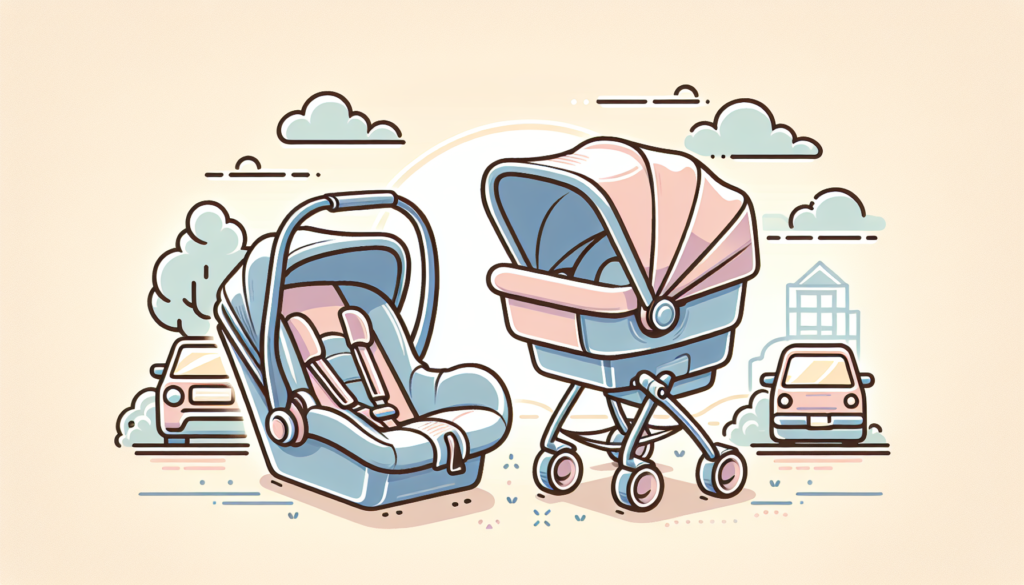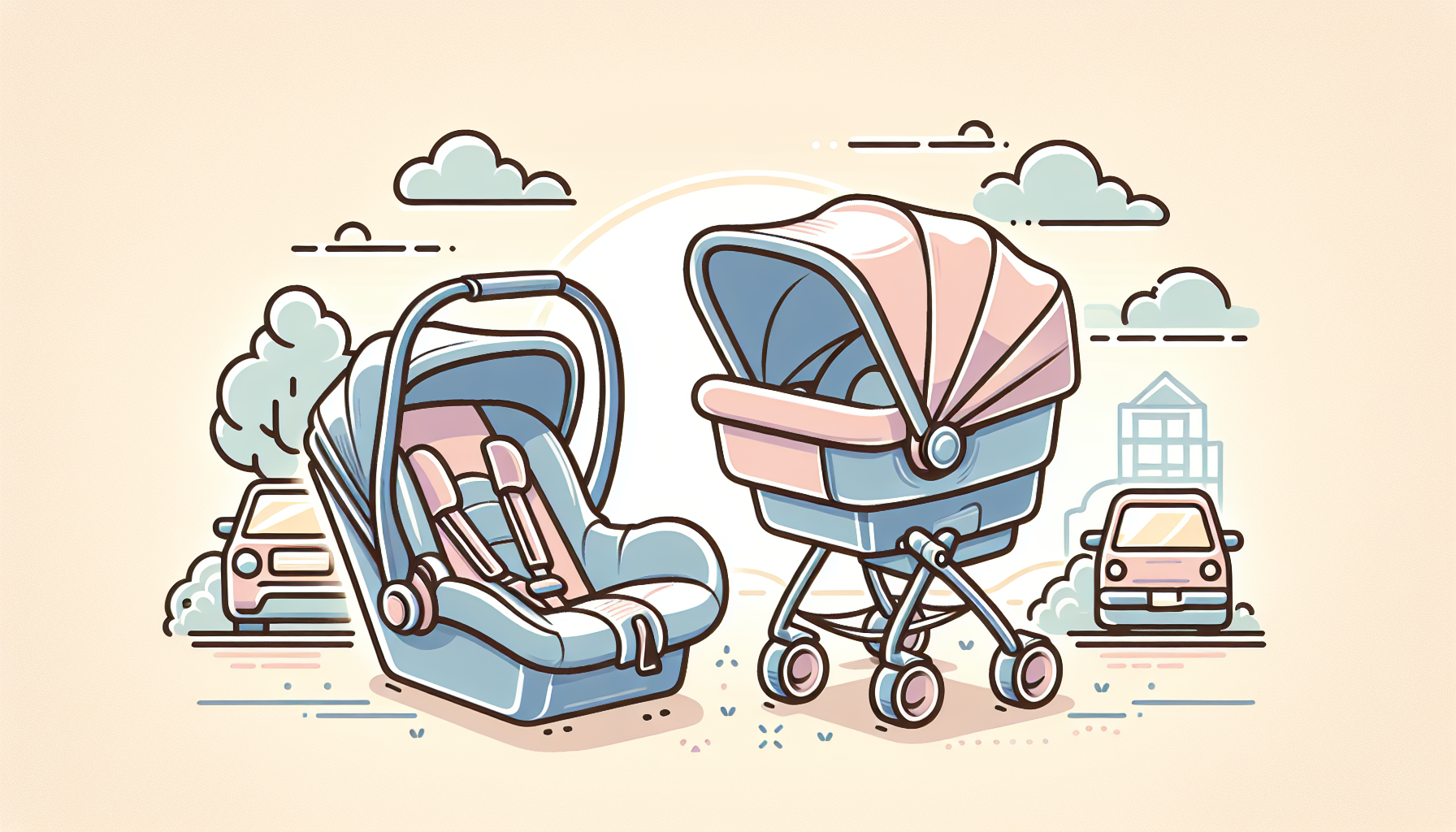Are you a new parent wondering when it’s safe for your little bundle of joy to sit in a stroller without a car seat? Well, fret no more! In this article, we will guide you through the age and development milestones that indicate when it’s time for your baby to take a seat in their stroller, sans car seat. From supporting head control to being able to sit up unassisted, we’ve got you covered. So grab a cup of tea, relax, and let’s delve into this exciting stage of your baby’s growth.

What is a car seat?
A car seat is a specially designed seat that helps to protect a child in a vehicle. It is installed in the car and provides a secure and comfortable seating arrangement for infants and young children. Car seats are essential for ensuring the safety of babies and toddlers while traveling by car. They are typically built with safety features such as adjustable harnesses, side-impact protection, and padding to minimize the risk of injury during a collision.
The benefits of using a car seat
Using a car seat for your baby or toddler offers several important benefits. Firstly, it provides crucial protection in the event of a car accident. Car seats are specifically designed to absorb and distribute the impact forces, reducing the risk of injury. They also help to keep your child securely in place, preventing them from being thrown around the vehicle in the event of sudden braking or a collision.
Additionally, car seats provide a comfortable and secure seating arrangement for your child. They are designed with padding and straps to ensure that your little one is properly supported and doesn’t slide around during the journey. This can help prevent discomfort and make the ride more enjoyable for your baby.
Furthermore, using a car seat is a legal requirement in many countries and states. By using a car seat for your child, you are not only ensuring their safety but also adhering to the law and avoiding potential penalties or fines. It is important to familiarize yourself with the specific car seat laws and regulations in your area to ensure compliance.
When can a baby sit in a stroller without a car seat?
The transition from using a car seat to a stroller without a car seat depends on the developmental milestones of your baby. Each child is unique, and it is important to consider their individual progress before making the switch. However, there are some general guidelines to keep in mind.
Babies can typically start sitting in a stroller without a car seat when they have developed sufficient head control. This typically occurs around 4-6 months of age. It is important that a baby can hold their head upright and steady before transitioning to a stroller without a car seat.
In addition to head control, your baby should also be able to sit independently. This means that they can maintain a seated position without any external support or assistance. This milestone usually occurs between 6-8 months of age.
Furthermore, your baby should have strong neck and core muscles to support themselves in a stroller without a car seat. This can be assessed by observing their ability to hold their head up while sitting and their overall stability.
Another important milestone is the ability to hold onto the stroller handles. This indicates that your baby has developed the necessary hand-eye coordination and strength to grip onto the stroller securely.
Lastly, your baby should demonstrate balance and stability. They should be able to sit upright without slumping to the side or falling over. This ensures their safety and comfort while sitting in a stroller without a car seat.
Developmental milestones for transitioning from car seat to stroller
Head control
To transition your baby from a car seat to a stroller without a car seat, they should have developed sufficient head control. This means that they can hold their head up and steady without any external support.
Sitting independently
Your baby should be able to sit independently without any external support or assistance. This indicates that they have developed the necessary strength and balance to maintain a seated position.
Strong neck and core muscles
Your baby should have developed strong neck and core muscles to support themselves while sitting upright in a stroller without a car seat. This can be assessed by observing their ability to hold their head up and their overall stability.
Ability to hold onto stroller handles
Your baby should demonstrate the ability to hold onto the stroller handles securely. This indicates that they have developed the necessary hand-eye coordination and strength to grip onto the stroller while sitting.
Balance and stability
Your baby should demonstrate balance and stability while sitting in a stroller without a car seat. They should be able to sit upright without slumping to the side or falling over, ensuring their safety and comfort.
Tips for safely using a stroller without a car seat
Transitioning your baby from a car seat to a stroller without a car seat can be an exciting milestone. However, it is important to ensure their safety during this transition. Here are some tips to help you safely use a stroller without a car seat:
Choose a stroller with a reclining feature
When selecting a stroller, opt for one that has a reclining feature. This allows you to adjust the angle of the seat to provide maximum comfort and support for your baby. A reclining seat can be especially beneficial for younger babies who may still need more head and neck support.
Invest in a stroller with a 5-point harness system
A 5-point harness system is an important safety feature to look for when choosing a stroller. This system consists of straps that secure your baby at their shoulders, hips, and between the legs. It provides optimal support and prevents your baby from sliding or falling out of the stroller.
Use supportive cushions or inserts
For added comfort and support, consider using supportive cushions or inserts in the stroller seat. These can help provide additional head and neck support for younger babies who may still need it. Ensure that the cushions or inserts are securely in place and do not interfere with the harness system.
Keep an eye on your baby’s comfort
Regularly check on your baby’s comfort while sitting in the stroller. Ensure that they are not slumping to one side or showing signs of discomfort. Adjust the seat position or use additional support if needed to ensure their comfort throughout the ride.
Avoid rough terrains and uneven surfaces
When using a stroller without a car seat, it is important to choose suitable paths and avoid rough terrains or uneven surfaces. The wheels of the stroller may not provide the same level of suspension or shock absorption as a car seat, so it is crucial to select routes that are smooth and easy to maneuver.
Always use the stroller’s safety features
Familiarize yourself with the safety features of your stroller and use them consistently. This may include features such as a locking mechanism, brake system, or safety tether. Ensure that all safety features are fully engaged and properly utilized to keep your baby secure in the stroller.
Alternatives to a stroller without a car seat
While transitioning from a car seat to a stroller without a car seat can be a significant milestone, it is important to consider alternative options that may better suit your baby’s needs. Here are some alternatives to consider:
Baby carriers
Baby carriers provide a hands-free way to carry your baby while still keeping them close and secure. There are various types of baby carriers available, including wraps, slings, and structured carriers. Baby carriers are a popular choice for parents who want to maintain a close bond with their baby while having the freedom to move around.
Travel systems
A travel system consists of a stroller that is compatible with an infant car seat. This allows you to easily click the car seat into the stroller, providing a seamless transition from car to stroller. Travel systems are convenient for parents who frequently use their car and want the flexibility of using the car seat and stroller together.
Convertible strollers
Convertible strollers offer the flexibility to adapt to your child’s changing needs. They can be used with a car seat in the early months and transitioned to a regular stroller seat as your baby grows. Convertible strollers provide a cost-effective and versatile option for parents who want a long-lasting stroller solution.
Additional considerations
When transitioning your baby from a car seat to a stroller without a car seat, there are additional factors to consider ensuring their safety and comfort. These considerations include:
Check the stroller’s age suitability
Before using a stroller without a car seat, ensure that it is appropriate for your baby’s age and developmental stage. Different strollers have different weight and age limits, so it is crucial to choose one that is suitable for your child.
Know the weight and height limits of the stroller
Pay attention to the weight and height limits of the stroller. Exceeding these limits can compromise the safety and stability of the stroller, potentially putting your baby at risk. Always refer to the manufacturer’s guidelines and recommendations for the specific stroller you are using.
Follow the manufacturer’s guidelines
It is important to carefully read and follow the manufacturer’s guidelines for using the stroller without a car seat. They provide essential information on the proper use, maintenance, and safety precautions specific to the stroller model. Following these guidelines will help ensure the optimal safety and functionality of the stroller.
Consult with a pediatrician for personalized advice
If you have any concerns or questions about transitioning your baby from a car seat to a stroller without a car seat, it is always advisable to consult with your pediatrician. They can provide personalized advice based on your baby’s unique developmental progress and ensure that you are making the right choice for your child’s safety and well-being.
In conclusion, transitioning your baby from a car seat to a stroller without a car seat is an important milestone in their development. It is crucial to carefully assess their developmental milestones, such as head control, sitting independently, strong neck and core muscles, the ability to hold onto stroller handles, balance, and stability before making the transition. By selecting a stroller with appropriate safety features, using supportive cushions or inserts, and following the manufacturer’s guidelines, you can ensure the safety and comfort of your baby while using a stroller without a car seat. Additionally, considering alternative options such as baby carriers, travel systems, or convertible strollers can provide additional flexibility and convenience. Always prioritize your baby’s safety and consult with your pediatrician for personalized advice to make the best decision for your child.

